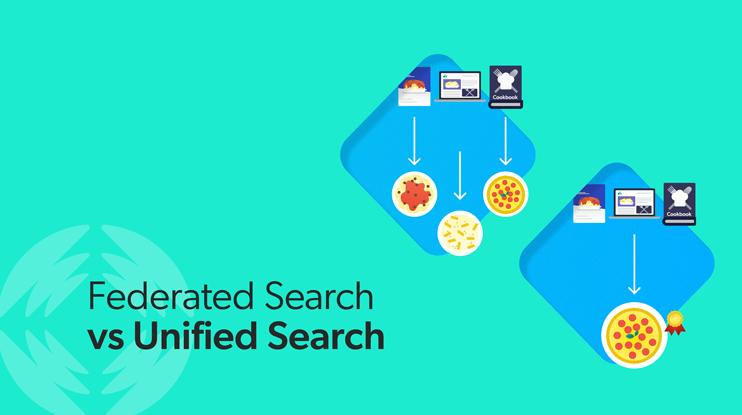The role of enterprise search cannot be overstated today. Especially with the recent advances in artificial intelligence and generative AI, having the right enterprise search software has become paramount to the success of every major organization. Without the proper foundation, these highly advanced tools cannot realize their full potential.
How do you know which type of enterprise search is right for your organization?
There are three different types of query systems: traditional search, federated search, and unified search.
In traditional search, the user has to log into separate search engines and search each one independently to find the information they’re looking for. Fortunately, this outdated method of information retrieval has largely been phased out today.
Federated search and unified search are two types of enterprise search that are widely used today. Both allow the user to search multiple data sources by sending a search query from a single search interface.
But there is one crucial difference between the two:
- In federated search, the search tool scans across multiple data sources that don’t talk to each other.
- In unified search, the system scans a single index that captures all the information about the content found in multiple sources.
On the surface, the difference between unified search vs federated search is minimal. How do you know which one is better for you?
Let’s dive deeper to find out.
Federated Search: Pros and Cons
When federated search first came along, it was a significantly more advanced search system than traditional search. The latter required users to log into multiple sources to find the different pieces of information they needed. That meant they had to know which data silo to look in, as well as remember all the passwords and logins for multiple databases.
Federated search changed all that as it gave users a single interface from which to send a search query to all these silos. While most traditional search methods only indexed a single data source at a time, federated search allowed indexing multiple data sources at once and then presenting the results to users in one unified interface.
Federated search retrieves information from a variety of information sources via a search application that’s built on top of search engine(s). When a user makes a single query, the federated search engine simultaneously searches multiple systems and information sources, returning the relevant results from all sources and presenting them in a single user interface.
Federated search became invaluable in complex organizations that have thousands of sources in the cloud and on-premise, where searching this via traditional search was simply unfeasible.
Let’s take a closer look at some of its pros and cons.
Pros
Fast and easy to implement
Federated search is relatively simple and fast to implement. Since it is a query-time merging method that doesn’t require setting up a central index (compared to unified search, which we’ll discuss in a moment), it can be set up pretty quickly.
Indices do not have to be standardized
Another advantage of federated search is that indices do not have to be standardized. If one dataset is in one format, and the other is in another format, that’s not a problem.
Always up-to-date
Since each individual index is maintained separately, as long as each of them is kept up-to-date, the federated search engine does not have to consistently go back and index the source to make sure the content and results are up to date.
Still, this method is not without shortcomings.
Cons
Impossible to achieve search relevance
The main problem is that with federated search it is impossible to achieve true relevance. Because each index is searched separately, the results are ranked by source—and ranking by relevance across different sources is impossible.
Poor search user experience
Users’ expectations from search today are sky-high. If you think a search experience consists of a search box plus a result page, think again. Users today expect much more from their search experience: they expect websites to interpret their misspellings correctly, anticipate their next move, learn from their previous clicks and searches and suggest related articles when appropriate.
That means that a good search experience today requires different additional capabilities such as autocomplete , query suggestions , filtering and faceting, and so on. This is nearly impossible to achieve in a federated search interface. Unless each separate index supports each of these capabilities, most federated search engines won’t be able to offer these.
Slow response times
In federated search, the response times will often be slow. Because it searches across multiple indices, the response time will be only as fast as its slowest content source.
Unified Search: Pros and Cons
Unified search differs from federated search in that it creates a single unified index of content from across all content repositories — including the option to crawl or push content stored in the cloud or on-prem via connector library or APIs — and ranks the entire corpus in a single user interface, applying relevance across the board and delivering meaningful results.
Unified search might take longer to set up than federated search, as the setup is dependent on the number, size, and location of sources.
Is the extra time and effort worth it?
With unified search, when the index is created, it captures all the information needed in order to apply consistent relevance ranking rules across all of your content for the queries that come in.
Here’s how unified search compares to federated search.
Faster response times
Unified search has faster query response times than federated search. This is because results are sourced from one unified index as opposed to searching multiple systems with search time merging. By contrast, in federated search, the response times are only as fast as its slowest content source.
Better relevance
With unified search, relevance is applied across the entire corpus of content and can even self-optimize with the application of machine learning. That means that the result list will always be ranked by relevance, regardless of the source.
Better UX experience
Unified search guarantees a better user experience. Search results are blended and pages can be built from a component library or APIs. Sorting, filtering, faceting and other capabilities of the search UX are built on top of the unified index.
Better foundation for generative AI
Unified search also provides a better foundation for the implementation of generative AI and large language models.
For example, Coveo’s Relevance Generative Answering uses its unified search platform to ground content by retrieving relevant content from trusted sources that a user is allowed to see. Access controls protect proprietary and private information so that only approved documents are fed to the large language models to generate the answer.
Unified Search vs Federated Search: Which Is Right For You?
A great enterprise search software enables users to search across multiple sources of information and find the most relevant data and gain valuable insights in a minimum search time.
It remains true and will always be true that data lives in multiple disparate systems and silos.
But users don’t need to know where the data they’re looking for is being pulled from. They just want relevant information that would get them to their goal as fast as possible.
The secret is to create a user experience where users don’t have to be distracted by irrelevant information such as which knowledge base the right content is hiding in.
In today’s world, people don’t want to spend time on searching and sorting. In fact, a good search experience today is one that doesn’t even require you to search.
Can you get there with a federated search? If your content comes from more than one data source (which is almost always the case), it will be nearly impossible.
Here is a summary comparing unified enterprise search and federated search, to help you decide which one is right for you:
| Unified Search | Federated Search | |
|---|---|---|
| Definition | Creates a single, unified index of content from all data sources, that is searched at one time. | Sends a query to separate search engines for each data source made available by the platform. |
| Content | ability to crawl or push content stored in the cloud or on-prem via connector library or APIs | relies upon a query federator that depends on the underlying search engine where the content resides |
| Relevance Tuning | apply relevance across the entire corpus of content and can even self-optimize with the application of machine learning | each search engine must be tuned independently, making it nearly impossible to provide a relative ranking across all content sources |
| Query Speeds | faster query response times as results are sourced from one unified index as opposed to searching multiple with query-time merging | query response times become an issue when the response for the results automatically defaults to the slowest content source |
| Search UI | search results are blended and pages can be built from a component library or APIs | search results are segmented by the system of origin and a user must navigate between sources |
| Sorting, Filters & Facets | sorting, filtering, faceting and other capabilities of the search UX are built on top of the unified index | all “federates” must support a capability (e.g. sort, filter, facets) for it to be made available in the UI |
| Index Setup Time | set up is dependent on the number, size, and location of sources | lower set up time as content is not crawled or standardized in an index |
| Security | use an early-binding permission retrieval method to import item permissions at crawling time | multiple security measures that need consideration as these are handled at the individual index level |
Today the search UX is incredibly important to users. A good search is one where you barely feel you’re doing the work of searching, but one that gets you to your desired outcome faster than you can say “lasagna.”
Don’t believe us? Give our trial a spin, which will allow you to build a search prototype in minutes!
Dig Deeper
Wondering where your search experience falls on the search spectrum? Find out with our Coveo Relevance Maturity Model. You can also get a search audit done by experts!


